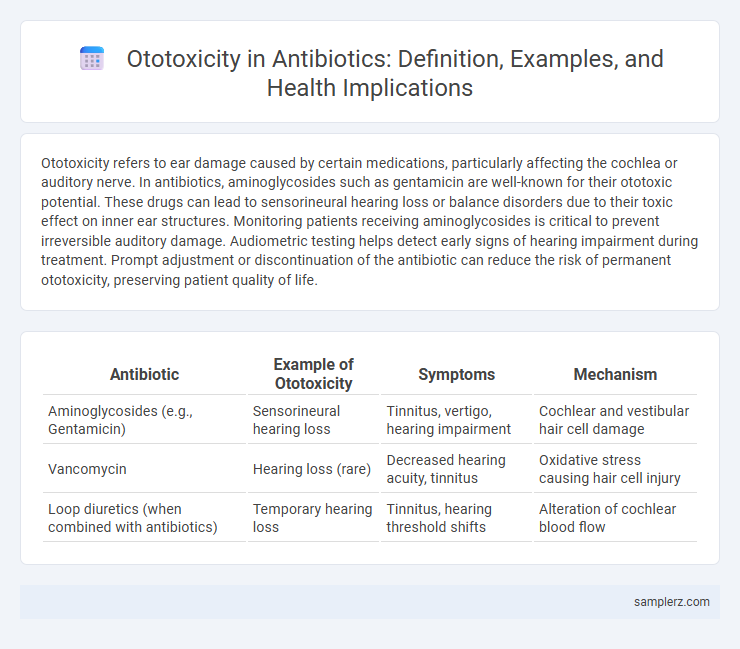Ototoxicity refers to ear damage caused by certain medications, particularly affecting the cochlea or auditory nerve. In antibiotics, aminoglycosides such as gentamicin are well-known for their ototoxic potential. These drugs can lead to sensorineural hearing loss or balance disorders due to their toxic effect on inner ear structures. Monitoring patients receiving aminoglycosides is critical to prevent irreversible auditory damage. Audiometric testing helps detect early signs of hearing impairment during treatment. Prompt adjustment or discontinuation of the antibiotic can reduce the risk of permanent ototoxicity, preserving patient quality of life.
Table of Comparison
| Antibiotic | Example of Ototoxicity | Symptoms | Mechanism |
|---|---|---|---|
| Aminoglycosides (e.g., Gentamicin) | Sensorineural hearing loss | Tinnitus, vertigo, hearing impairment | Cochlear and vestibular hair cell damage |
| Vancomycin | Hearing loss (rare) | Decreased hearing acuity, tinnitus | Oxidative stress causing hair cell injury |
| Loop diuretics (when combined with antibiotics) | Temporary hearing loss | Tinnitus, hearing threshold shifts | Alteration of cochlear blood flow |
Common Antibiotics Linked to Ototoxicity
Common antibiotics linked to ototoxicity include aminoglycosides such as gentamicin, tobramycin, and amikacin, which can cause irreversible damage to the cochlea and vestibular system. Vancomycin, especially when combined with other ototoxic drugs, is also associated with hearing loss and balance disturbances. Monitoring serum drug levels and auditory function during treatment is crucial to prevent permanent ototoxic effects.
How Aminoglycosides Cause Hearing Loss
Aminoglycosides, a class of antibiotics including gentamicin and amikacin, cause hearing loss by damaging the hair cells in the cochlea responsible for sound detection. These drugs induce the production of reactive oxygen species within the inner ear, leading to oxidative stress and apoptosis of sensory cells. The cumulative effect results in irreversible sensorineural hearing impairment commonly seen in patients undergoing prolonged aminoglycoside therapy.
Early Signs of Antibiotic-Induced Ototoxicity
Early signs of antibiotic-induced ototoxicity often include tinnitus, a persistent ringing or buzzing sound in the ears, and mild hearing loss, particularly at high frequencies. Patients may also experience dizziness or balance disturbances, indicating vestibular involvement. Prompt recognition of these symptoms is crucial to prevent irreversible auditory damage caused by aminoglycosides like gentamicin.
Risk Factors for Ototoxic Side Effects in Antibiotic Use
Aminoglycoside antibiotics such as gentamicin and amikacin are commonly associated with ototoxicity, leading to irreversible hearing loss. Risk factors for ototoxic side effects include prolonged therapy duration, high cumulative doses, impaired renal function, and concurrent use of other ototoxic drugs like loop diuretics. Genetic predispositions and advanced age also significantly increase susceptibility to antibiotic-induced auditory damage.
Monitoring Ototoxicity in Patients on Antibiotics
Monitoring ototoxicity in patients receiving aminoglycoside antibiotics, such as gentamicin and amikacin, is critical to prevent irreversible hearing loss. Regular audiometric testing and vestibular assessments should be conducted before, during, and after therapy to detect early signs of cochlear or vestibular damage. Serum drug level monitoring combined with renal function tests enhances the safety profile by minimizing ototoxic exposure.
Case Studies: Ototoxicity from Antibiotic Treatment
Case studies of ototoxicity from antibiotic treatment frequently highlight aminoglycosides, such as gentamicin and amikacin, which are well-documented for their cochlear and vestibular toxicity leading to irreversible hearing loss. Patients receiving prolonged or high-dose aminoglycoside therapy exhibit symptoms ranging from tinnitus and vertigo to profound sensorineural hearing impairment, often confirmed through audiometric testing. Monitoring serum drug levels and auditory function during treatment is critical to preventing permanent ototoxic damage in vulnerable populations.
Preventing Ototoxicity in High-Risk Patients
Aminoglycoside antibiotics such as gentamicin are common examples of ototoxic drugs that can cause sensorineural hearing loss, particularly in high-risk patients like those with pre-existing renal impairment or concurrent loop diuretic therapy. Monitoring serum drug levels, limiting duration of therapy, and conducting regular audiometric evaluations are critical strategies to prevent ototoxicity in vulnerable populations. Prompt recognition of early symptoms, including tinnitus and hearing changes, facilitates intervention to minimize permanent auditory damage.
Alternatives to Ototoxic Antibiotics
Aminoglycosides are well-known ototoxic antibiotics that can cause irreversible hearing loss by damaging the cochlear hair cells. Alternatives such as macrolides (e.g., azithromycin) and cephalosporins (e.g., ceftriaxone) provide effective antibacterial coverage with a significantly lower risk of ototoxicity. Using these non-ototoxic antibiotics is crucial in patients with pre-existing hearing impairment or those requiring prolonged treatment to preserve auditory function.
Recommendations for Safe Antibiotic Prescription
Prescribing aminoglycosides like gentamicin requires careful monitoring due to their high ototoxicity risk, especially in patients with renal impairment or existing hearing loss. Utilizing therapeutic drug monitoring (TDM) and limiting dosage duration can reduce auditory damage while ensuring effective bacterial eradication. Integrating audiometric testing before and during treatment helps detect early signs of ototoxicity, guiding adjustments for safer antibiotic use.
Recovery and Management After Antibiotic Ototoxicity
Hearing recovery after antibiotic-induced ototoxicity varies depending on the specific drug and duration of exposure; aminoglycosides often cause irreversible damage, while early intervention with corticosteroids may improve outcomes. Regular audiometric monitoring during treatment with ototoxic antibiotics is essential for early detection, allowing prompt discontinuation to minimize further hearing loss. Rehabilitation approaches, including hearing aids or cochlear implants, enhance quality of life for patients with persistent auditory deficits following ototoxic injury.

example of ototoxicity in antibiotic Infographic
 samplerz.com
samplerz.com